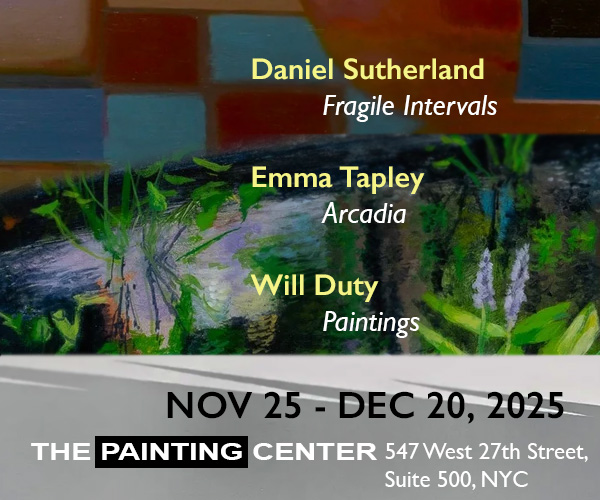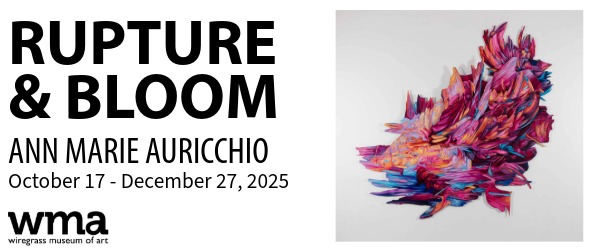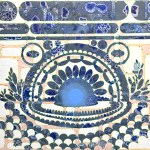
Contributed by Holly Coulis / This interview took place on February 13, 2022, on the occasion of the two-person show, “Erin O�Brien and Keiko Narahashi,” at 106 Green, in New York City.
Holly Coulis: Has sharing the space at 106 Green brought things to light in your work that were less obvious to you before this showing?
Erin O’Brien: Not exactly, but it has caused me to sometimes see the shapes in my paintings as individuals, like they might each have their own personalities. I do really love the conversation happening in this show. There�s a great energy in the room.
Keiko Narahashi: I was surprised by the amount of color in the show. I think it�s the first thing you notice when you walk in. I�ve actually been moving away from that recently, focusing more on form, with color limited to a darker palette. But seeing our work together reminded me of the pleasures of pure color, and I�m already thinking of how I can get back to that.


HC: You both use areas of flat color in your work. How do you see flat color functioning in a painting/sculpture? Are they voids? Presences? What is the allure of a field of color? Is it historical, etc?
EO: Yes, all of the above. I first fell in love with areas of flat color because they could be both a presence and a void, depending upon the color situation within the painting. And even better, with the right color combination, you can make a flat area fluctuate from presence to void and back again the longer one looks at the painting. I think about absence as a presence a lot in my work, and color is one way I play with this, along with using the exposed linen as both support and actor.
KN: With my Color Planes, I wanted to present color on its own, as on a canvas, but to make it an object that doesn�t �disappear� as a support. My pieces take up space but retain their planar properties in a kind of frontal presentation (like a painting), propped up like a picture frame or stage prop. I like how simple and straightforward it is as an object, yet references painting ideas. In different ways, I think Erin and I are both thinking about ways of activating this painting surface and structure.


HC: The edge work is compelling. Can you talk a little about how you determine what an edge should do to the painting/sculpture? How do you decide how to divide areas of color?
EO: Such a good question. For me, it’s all about the context of the other edges within the painting. I want a lot of subtle variation as your eyes scan the surface. If I�ve put down a wash that seeps into the linen, I want to play off of that with a slightly built-up shape that has both crisp and ragged edges, or with dry-brushed paint. The paintings are often spatial conundrums, and by varying the edges within each piece, I�m quietly bringing the viewer back to their physicality.
KN: I�m all about edges and shapes! I think maybe we are all born with an innate shape language which we�re drawn to over and over again. In some ways, it�s more personal than color. With the Color Planes, I draw onto a slab of clay with a sharp tool that cuts out the shape, so they�re basically cut-out drawings. I do this freehand so there�s an immediate translation into a 3-dimensional world, yet they retain their 2-dimensionality because they�re still basically propped up drawings.
HC: In each of your practices, there is a tension between abstraction and figuration. And depending on the piece, it can swing more heavily to one or the other. Why is this juxtaposition interesting to you? How do you see human bodies and abstraction (what is unreal) interacting?
EO: The question of what to reveal and what to conceal has always been in my work. The paintings arises from a feeling of intimacy with a place or person, or often, both. I draw the shapes that form my compositions from my own photos and sketches. Some are composites, others are fragments or negative spaces. My source materials serve as mnemonics, but I combine elements from them and turn them into compositions that can be read several different ways. The compositions hold this residue but are of the present moment. I don�t yet have succinct language to describe why I�m now starting to leave certain images legible, but it has something to do with expanding the spectrum of possible experience for myself and for the viewer. How does it affect the reading of a piece?

KN: This question really hits the target for me. My whole life is about this tension�what is factually experiential, and what is allegorical, part of a centuries old human condition that we talk about as myth or fable. Where I stand in the world can feel very much rooted in the present, at the same time I can feel like the star of my very own hero�s quest. (This may be a consequence of Pandemic Times.) I would also add the element of time�the sense of being both in and out of time. In literal terms, I�m increasingly drawn to stories in my work, and the question of how figurative or how abstract I want to go is the line that I�m walking. There needs to be a transformation, as in all art, but whether that leads to more abstraction is a question I�m grappling with.

HC: The shapes of the edges seem to consist of a combination of flat or sharp edges, and softer, more organic shapes, some that even seem to undulate. Can you talk about the importance of these shapes to the overall pieces?
EO: I want the work to nod toward both body and architecture, while often being slightly in tension with the rectangle of the support. Years ago, when I was sorting through a repetitive strain injury in my arms and neck, caused by a combination of bad posture and holding stress in my muscles, the edge of the canvas became something I was both working with and against. I�d become deeply aware of my body in a new way, and diagonals and slightly off geometry suddenly made intuitive sense.
KN: For me, this has a lot to do with the act of making a slab in clay. You can roll it out like a pie crust and cut out the shape. Or there is a more free-form way of making a slab, which is more akin to throwing a pizza crust in the air. I liken it to breathing. I always make a decision at some point, to either cut out a shape, thereby controlling the edge, or to use the organic shape of the slab as is, with its rough edges and rounder form. One feels architectural, the other more like internal organs.


HC: In different ways, your works rely on the shadow. Is this purposeful or incidental? The difference between how this presents itself in a sculpture v a painting is interesting. Would you comment on each other’s use of the shadow, as well as your own?
EO: It�s so interesting because I don�t think of shadows in my own work at all, more just absences and presences. In Keiko�s work, the two explicitly figurative pieces are heads that sit on black shapes. I read those shapes not as shadow per se, but rather as all that remains unspoken by that head, or the grief that lies underneath the head�s everyday experiences.
KN: I love that description, Erin! Shadows, especially in the form of a silhouette, have been an ongoing obsession of mine since childhood. Our shadows inform us of where we stand. (I�ve recently come across videos of small children discovering their shadow for the first time and shrieking in terror.) The silhouette is both anonymous and specific, a wonderful quality to hide behind. What interests me about Erin�s work is that at first glance, the dark areas can read as shadows, but on closer scrutiny, they often overlap a lighter form. They can be read as voids or presences, but not really shadows. I think perhaps shadows are too literal in the world she is creating, they can steal the ambiguity she is going after.
As for my work, the various metaphorical meanings of the shadow, from Plato to Tanizaki to Jung, are always in the back of my mind, like a shadow.

HC: Another area where there is some overlap, is in your senses of color. Are there things that you draw color from? Nature, particular artworks, etc? Were you surprised by how beautifully your two worlds meshed, color-wise? How would you describe your individual color sensibility?
EO: I was totally surprised by how similar our color is. I pull colors from nature, from other artworks, and from my own photos. I start each painting with the color of the linen and one paint color. It could be the color of late afternoon sun in a photo I�ve taken, or a gorgeous blue from a Bonnard painting, for example. I don�t plan the rest of the palette, but rather mix each color in turn as the painting develops. My color sensibility definitely leans more toward nature than the purely synthetic. [And I agree completely with Keiko about Indian miniatures and the 13th and 14th century Italians!]
KN: I was very happily surprised by the color conversation in our show. The room really glows! In particular, I love Erin�s use of �beige�, either as the linen or paint, in concert with her other colors. It operates both as a color exercise and as something more ineffable, like the void (atmosphere) or presence (shape).
I am drawn to color in nature but interpreted through art�Indian miniature paintings or Japanese woodcuts. Lately I�ve been looking at sacred paintings from Italy, Giotto in particular. Love that Catholic color!

HC: Both of your works seem to arise out of very quiet, peaceful spaces. Is this true or are you blasting heavy metal while you work?
EO: Ha! I need to make those quiet, peaceful spaces for myself. Painting can bring me into that state. Sometimes I�m listening to a podcast or to Bach, other times I�m listening to T. Rex, Elmore James, or the Silver Jews.
KN: I reserve the heavy metal for cleaning days. Actually it�s more like angry Beyonce. Otherwise, I like this noodly Japanese music, which sort of feels like my daydreaming mind. Akira Kosemura, aspidistrafly, Haruka Nakamura. I also just acquired an internet smart radio and have been listening to all kinds of music from everywhere. So much fun.
HC: If you could only make one comment about each other’s work, what would it be?
EO: Keiko�s work is quietly powerful and beautiful.
KN: Quiet, reserved, still, sneak attack, revelatory. (In that order.)
“Erin O�Brien and Keiko Narahashi,” 106 Green, 75 E Broadway Suite 203C, New York, NY. Through February 19. Note: Closing reception Saturday, February 19, 4-6pm
About the Artists:
Erin O�Brien was born in Massachusetts, and lives and works in Brooklyn, NY. She holds an MFA from Bard College and a BFA from Massachusetts College of Art. Her work has been shown at Kathryn Markel Fine Art, New York, NY; Mana Contemporary, Jersey City, NJ; Palazzo Monti, Brescia, Italy; Tiger Strikes Asteroid, Brooklyn, NY; LaMama Galleria New York, NY; and Hyde Park Art Center, Chicago, IL, among others. Her paintings were featured in Art Maze Magazine, Issue 11, and an interview with her appeared in Maake Magazine, Issue 6. O�Brien is the recipient of residency fellowships from Palazzo Monti, Brescia, Italy; Weir Farm National Historic Site, Wilton, CT; Byrdcliffe, Woodstock, NY; and Anderson Ranch Arts Center, Snowmass, CO.
Keiko Narahashi was born in Tokyo and lives and works in New York City. She received a BFA from Parsons school of Design, and an MFA in Painting from Bard College. Recent exhibitions include Jason McCoy Gallery (NYC), Carvahlo Park (Brooklyn), Jack Hanley Gallery (NYC), Underdonk Gallery (Brooklyn), Bennington College Usdan Gallery, and Hofstra University Rosenberg Gallery, among others. She was a recipient of the Marie Walsh Sharpe Foundation studio grant (2005) and a New York Foundation for the Arts Fellowship Grant in Painting (2006). Her work has been written about in publications such as The New Yorker, Vogue, The Brooklyn Rail, and The New York Times. She was recently featured in New York Studio Conversations, Part II, edited by Stephanie Buhmann (2018, The Green Box, Berlin). She will have a solo exhibition at Tappeto Volante (Brooklyn) in February.
About the author: Painter Holly Coulis lives and works in Athens, Georgia. Her solo show, “Eyes and Yous,” was at Klaus von Nichtssagend (New York) through February 12, 2022.
Related posts:
Installation view: Machines of Paint and Other Materials
Installation view: Drishti, a concentrated gaze























The fluctuations of color, and the interplay of opaque and transparent pigments, are a wonderful meditation on surface and depth. Thank you for this thoughtful and thought-provoking interview!